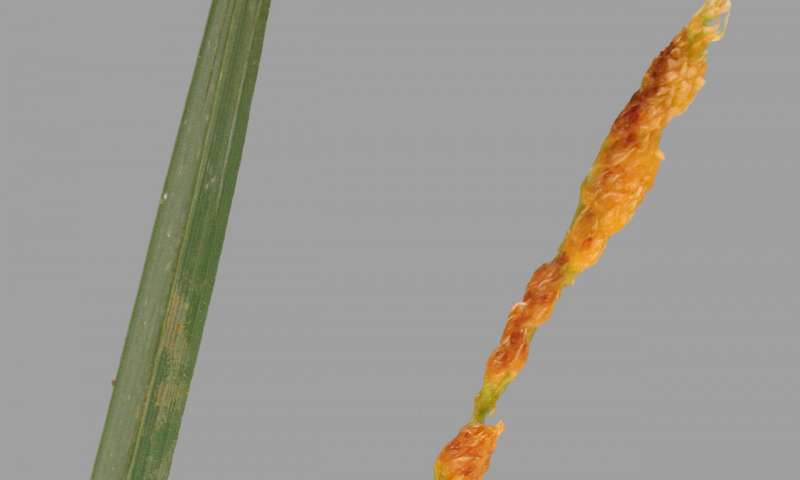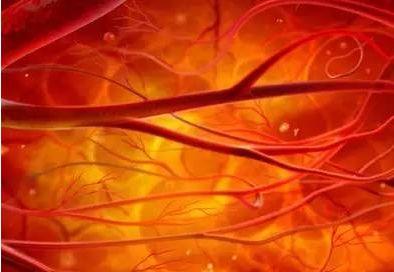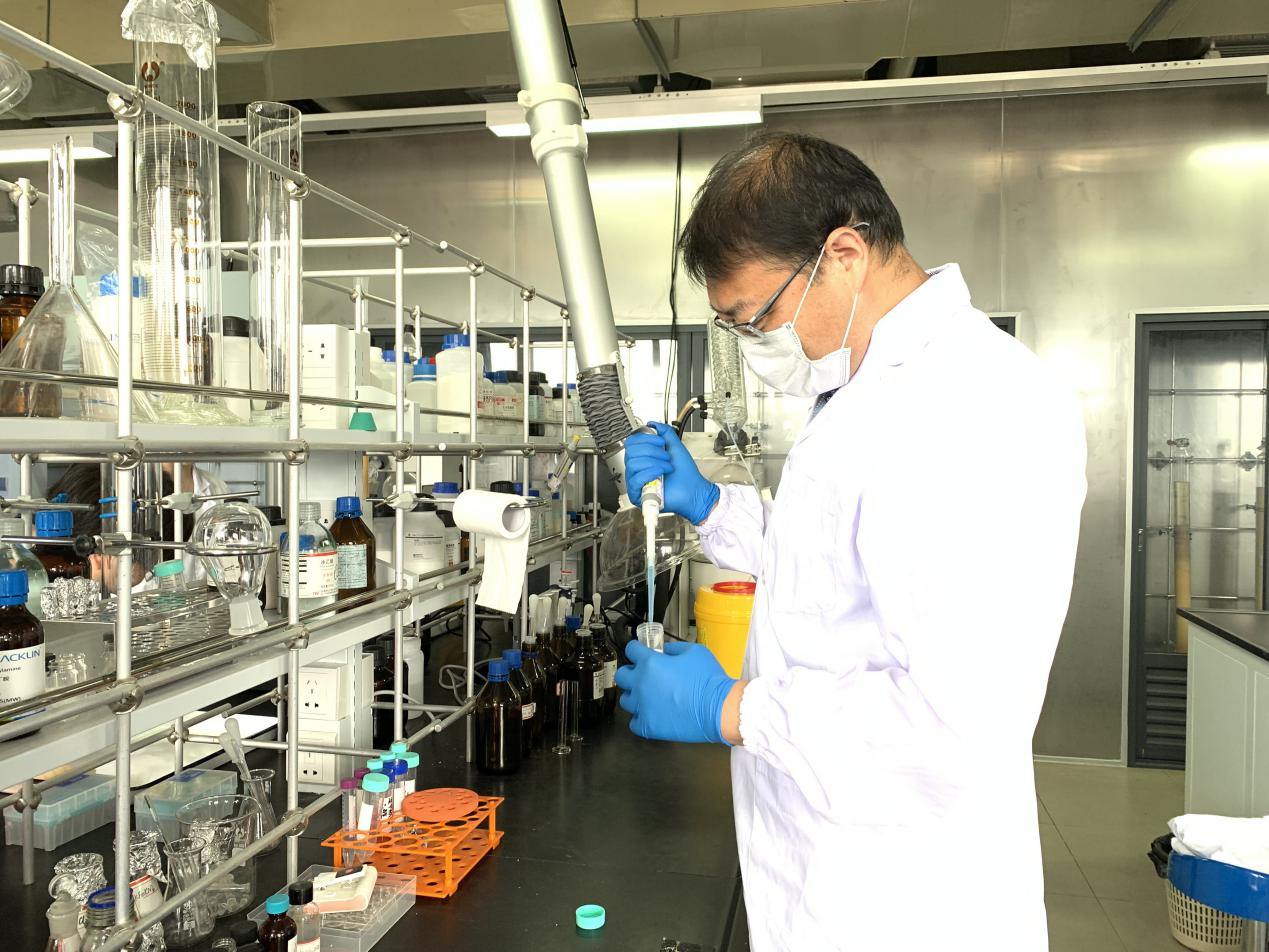研究人员说CRISPR致命细菌的影响力较低的遗传多样性
Scientists at Oregon State University have shed light on the evolutionary history of a soil-borne bacteria that is so dangerous to grazing animals it is kept behind lock-and-key to prevent its spread.
Somewhere along the way, Rathayibacter toxicus lost about one-third of its genes. Yet it persists in spite of its genome reduction and low genetic diversity. In a new study, researchers propose a process that emphasizes the importance of the bacteria's reaction to viral infection. At the center of that process is a clustered regularly interspaced short palindromic repeat (CRISPR) locus.
The U.S. government has declared R. toxicus to be a biological select agent for toxins and specimens are handled at highly secure federal facilties. There is no evidence of the bacterial species in Oregon but concerns are high because the worm that transports it to plants is found in the state. In addition, the worm and bacteria both infect grass seedheads. In 2017, hay and grass seed were the third- and fifth-largest agricultural commodities in Oregon, with a combined value of more than $1 billion.
"The ability to detect and preemptively prevent the movement of R. toxicus is vitally important," said Jeff Chang, a microbial genomicist in OSU's College of Agricultural Sciences and the study's corresponding author. "It's one thing to see an infected grass, it's another to detect microbes before you even see their effects. With genome-enabled epidemiology, we can track the movement of specific lineages of bacteria and try to stop them from moving around."
CRISPRs are used in genome editing technology but are less known for their ecological roles. In this study, the scientists relied on whole genome sequencing to understand how different species of Rathayibacter are related and how they evolve.
"Now that we have a whole genome sequenced and understand it, we can identify specific sequences that can be used for molecular diagnostics. That could be a powerful way to massively survey seed lots to find out if R. toxicus is present," Chang said.
In the study, the researchers used DNA extracted from R. toxicus collected during a 30-year period of sampling in three regions of Australia. Their analysis also included strains collected from seeds produced in Oregon. R. toxicus was not detected in seed samples from Oregon, and the two dominant species of Rathayibacter found in Oregon lack the genes necessary to make the toxin that has afflicted grazing animals in Australia.
More than 100 sequenced Rathayibacter genomes were analyzed. R. toxicus is the most genetically distant, and that's likely because it is the only Rathayibacter to have acquired a CRISPR adaptive immune system to protect against viruses, said Ed Davis, an OSU doctoral graduate and one of the study's co-lead authors.
"In its evolution, not only did it lose genes but it gained genes, including the CRISPR locus," Davis said. "It gained genes that other Rathayibacter bacteria don't have. Its genome is normal, except some sections were removed. This suggests that this species experienced a dramatic event in its evolution."
Read more at: https://phys.org/news/2018-10-crispr-genetic-diversity-deadly-bacteria.html#jCp
俄勒冈州立大学的科学家们揭示土传细菌的进化历史是如此危险的食草动物留下来锁钥,防止其扩散。一路走来,Rathayibacter toxicus损失了三分之一的基因。但它持续减少尽管基因组和遗传多样性较低。在一项新的研究中,研究人员提出一个过程,强调了细菌对病毒感染的反应的重要性。这一过程的中心是一个经常聚集空间短回文重复CRISPR位点。

美国政府已经宣布r . toxicus生物选择代理毒素,在高度安全的联邦别的处理标本。没有证据的细菌物种在俄勒冈州但担忧很高因为蠕虫运输到植物中发现。此外,蠕虫病毒和细菌感染草seedheads。2017年,干草和草籽是第三和第五大农产品在俄勒冈州,价值总计超过10亿美元。
”的能力检测和预先防止运动r . toxicus至关重要,”Jeff Chang说,微生物genomicist在俄勒冈州立大学农业科学学院和该研究的通讯作者。“是一回事看到受感染的草,这是另一个检测微生物甚至在你看到其效果。随着基因组使流行病学,我们可以跟踪特定的运动血统的细菌,试图阻止他们移动。”
CRISPRs用于基因组编辑技术,但不太出名的生态角色。在这项研究中,科学家们依靠全基因组测序来了解不同种类的Rathayibacter相关以及如何演变。
“现在我们有一个全基因组测序和理解它,我们可以识别特定的序列,可以用于分子诊断。这可能是一个强大的种子很多大规模调查发现如果r . toxicus存在,”张说。
在这项研究中,研究人员使用DNA提取r . toxicus收集30年期间澳大利亚三个区域的抽样。他们的分析还包括压力来自俄勒冈州生产的种子。r . toxicus种子样本中没有检测到俄勒冈州的两个优势种Rathayibacter发现在俄勒冈州缺乏必要的基因,使毒素,折磨食草动物在澳大利亚。
超过100测序Rathayibacter基因组进行了分析。r . toxicus基因是最遥远,这是可能的,因为它是唯一Rathayibacter获得了CRISPR适应性免疫系统来抵御病毒,俄勒冈州立大学的博士研究生和埃德·戴维斯说研究的联合作者之一。
”在其进化,它不仅失去基因,但它得到了基因,包括CRISPR位点,”戴维斯说。“这,其他Rathayibacter细菌没有获得基因。其基因组是正常的,除了一些部分被删除。这表明这个物种进化经历了戏剧性的事件。”
推荐内容
-
幼儿心理健康教育一体化和个别化
现实生活中,我们很难揣测出一个人的心理活动。但是我们可以根据一些知识的细节,去假设判断一些人的心理,也包括对自己的心理的认知。...
-
哈尔滨市卫生健康委驰援双城疫情防控工作侧记
哈尔滨市卫生健康委驰援双城疫情防控工作侧记 2022年4月14日,哈尔滨市双城区在全民核酸检测中发现阳性感染者,面对可能存在的社区扩
-
一到冬天骨头就变脆?真是如此?
相信很多人都被“误导”过。因为现在的网络信息非常丰富和更新迅速,还没等我们了解事情的详情,下一秒就又反转了。所以大家在获取信息...
-
低温会增加紫外线辐射造成DNA损伤的风险
紫外线(UV)辐射可引起DNA损伤,可能是全球两栖动物灭绝危机的原因之一。来自澳大利亚昆士兰大学的Craig Franklin教授和一组研究人员的最新
-
基因港、瑞维拓提及的赛立复CELFULL的科研背景是什么
基因港、瑞维拓提及的赛立复CELFULL的科研背景是什么?想必很多人都不知道吧!那么就跟随小编去看看吧!谷歌首席未来学家科兹威尔曾经指出,伴




